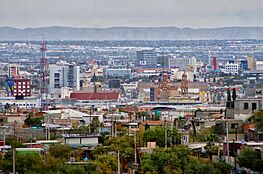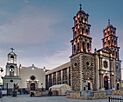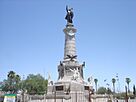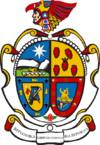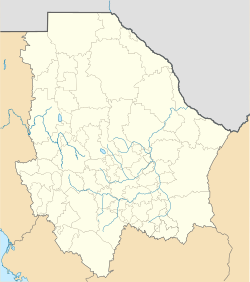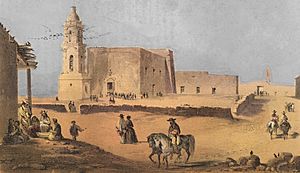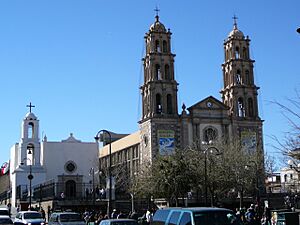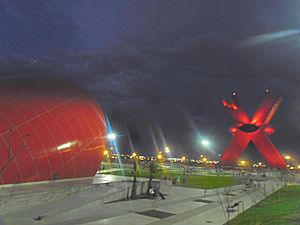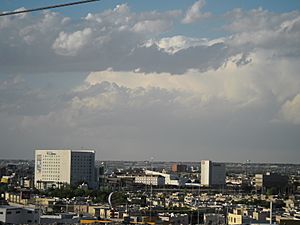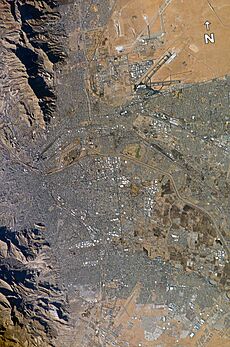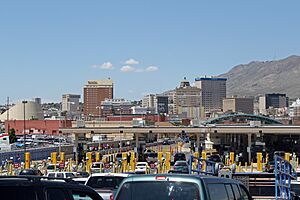Ciudad Juárez facts for kids
Quick facts for kids
Ciudad Juárez
Tsé Táhú'ayá (Lipan)
Juárez
|
||
|---|---|---|
|
Ciudad Juárez skyline
Parque Central
Misiones Zone
Ciudad Juárez Cathedral and Guadalupe Mission
Benito Juárez Monument
Museum of the Revolution on the Border
Monument to the Mexican People
|
||
|
||
| Nicknames:
El Paso del Norte ("The North Pass")
|
||
| Motto(s):
Refugio de la libertad, custodia de la república (Spanish for "Refuge of liberty, guard of the republic")
|
||
| Country | Mexico | |
| State | Chihuahua | |
| Municipality | Juárez | |
| Foundation | 1659 | |
| Named for | Benito Juárez | |
| Area | ||
| • City | 321.19 km2 (124.01 sq mi) | |
| Elevation | 1,140 m (3,740 ft) | |
| Population
(2020)
|
||
| • City | 2,143,539 | |
| • Rank | 16th in North America 6th in Mexico |
|
| • Density | 4,113.25/km2 (10,653.26/sq mi) | |
| • Metro | 2,539,946 | |
| • Demonym | Juarense | |
| GDP (PPP, constant 2015 values) | ||
| • Year | 2023 | |
| • Total | $41.0 billion | |
| • Per capita | $25,900 | |
| Time zone | UTC-07:00 (MST) | |
| • Summer (DST) | UTC-06:00 (MDT) | |
| Area code(s) | +52 656 | |
| Climate | BWk | |
Ciudad Juárez (often called just Juárez) is a large city in Mexico. It is the most populated city in the state of Chihuahua. Until 1888, it was known as El Paso del Norte, meaning "The North Pass".
Juárez sits on the Rio Grande (Río Bravo del Norte) river. It is located just south of El Paso, Texas in the United States. Together, Ciudad Juárez and El Paso form a huge area where two countries meet. This area has over 3.4 million people. It is the second largest border area between Mexico and the U.S.
Many bridges connect Ciudad Juárez and El Paso. These bridges help people and goods move between the two countries. In 2008, over 22 million crossings happened here. This makes Ciudad Juárez a very important entry point into the U.S. for northern Mexico. The city is also a growing industrial hub. It has over 300 maquiladoras, which are factories that assemble products. In 2008, a magazine called fDi Magazine named Ciudad Juárez "The City of the Future."
Contents
History of Ciudad Juárez
Spanish explorers came to this area in the 1600s. A friar named García de San Francisco founded Ciudad Juárez in 1659. He called it "El Paso del Norte." The first permanent Spanish settlement was the Guadalupe Mission in the 1660s. This community grew as trade between Santa Fe and Chihuahua passed through it.
Native groups like the Mansos and Suma-Jumano lived here. In 1680, during the Pueblo Revolt, many native people became refugees. Missions were set up for them.
During the Mexican–American War, a battle happened nearby in 1846. After the war, in 1848, the Treaty of Guadalupe Hidalgo made the Rio Grande the border. This split the area, with some towns ending up in Texas.
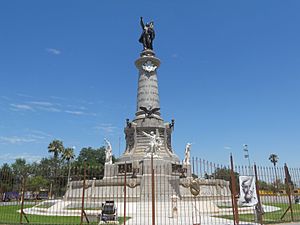
In 1853, more land was sold to the U.S. This made Paso del Norte even more important as a border town. During a time when France tried to control Mexico (1862–1867), Benito Juárez's government stayed here for a while. In 1888, the city was renamed in his honor.
After 1882, the city grew a lot. This was because the Mexican Central Railway arrived. Businesses thrived, with new banks, telegraphs, and trams.
City Growth Under Porfirio Díaz
The city expanded greatly due to Porfirio Díaz's free-trade policy. This created new shops and services. A bullring opened in 1899. In 1906, the first college, the Escuela Particular de Agricultura, was founded.
Public works like sewage, drainage, and clean water systems were built. New libraries, schools, and parks also appeared. Modern hotels and restaurants were built for travelers. However, economic problems caused many workers to move to the U.S. So, Ciudad Juárez focused on tourism in the early 1900s.
In 1909, President Díaz and U.S. President William Howard Taft met in Ciudad Juárez. This was the first time a U.S. president crossed into Mexico. Many security forces were present for their safety. On the day of the meeting, a man with a hidden gun was caught near the presidents.
Mexican Revolution and Recovery
By 1910, Ciudad Juárez was Mexico's largest border town. This made it very important during the Mexican Revolution. In May 1911, about 3,000 revolutionary fighters attacked the city. They were led by Francisco I. Madero. After two days of fighting, the revolutionaries took control.
Taking this border town helped the revolutionaries get weapons and supplies. It also showed that the old government was losing power. During the revolution, Pancho Villa and other leaders fought for control of the city. Much of the city was destroyed in battles in 1911 and 1913. Many people left the city between 1914 and 1917.
From the 1920s to the 1940s, tourism, gambling, and light manufacturing helped the city recover. In the 1940s to 1960s, mayors like Carlos Villareal helped the city grow even more. A program to develop border industries helped a lot. The city center was beautified with new buildings and a cathedral. By 1970, the city's population reached about 400,000.
Juárez has grown a lot recently. Many people have moved here looking for jobs in the maquiladoras. By 2014, more technology companies came to the city. For example, the Delphi Corporation Technical Center is the largest in the Western Hemisphere. It employs over 2,000 engineers.
Export Exchange
Juárez is known as a top city for exports. In 2020, international sales from Juárez were over $54 billion. This was 13.7% more than the year before. The city sells many things, like data processing machines and electrical wires.
In 2020, Juárez also bought over $48 billion in goods from other countries. This included electronic parts and machine accessories.
Geography and Climate
Climate
Ciudad Juárez is in the Chihuahuan Desert. It is also at a high altitude. This means it has a cold desert climate. The seasons are clear: hot summers, mild springs and autumns, and cold winters.
Summer temperatures average around 35°C (95°F). Winter temperatures average around 14°C (57°F). It does not rain much, but most rain falls in summer. Snow sometimes falls, about four times a year. In December 2015, the city got 40 cm (16 inches) of snow in one day. The highest temperature ever recorded was 49°C (120°F). The lowest was -23°C (-9°F).
| Climate data for Ciudad Juárez (Downtown), elevation: 1,135 m (3,724 ft), 1971-2001 normals | |||||||||||||
|---|---|---|---|---|---|---|---|---|---|---|---|---|---|
| Month | Jan | Feb | Mar | Apr | May | Jun | Jul | Aug | Sep | Oct | Nov | Dec | Year |
| Record high °C (°F) | 28.0 (82.4) |
30.0 (86.0) |
33.0 (91.4) |
39.0 (102.2) |
42.0 (107.6) |
49.0 (120.2) |
44.0 (111.2) |
41.5 (106.7) |
41.0 (105.8) |
38.0 (100.4) |
30.1 (86.2) |
34.0 (93.2) |
49.0 (120.2) |
| Mean daily maximum °C (°F) | 13.7 (56.7) |
16.9 (62.4) |
20.1 (68.2) |
27.0 (80.6) |
31.6 (88.9) |
35.6 (96.1) |
35.5 (95.9) |
34.6 (94.3) |
31.1 (88.0) |
25.8 (78.4) |
19.1 (66.4) |
15.7 (60.3) |
25.6 (78.1) |
| Daily mean °C (°F) | 5.8 (42.4) |
8.4 (47.1) |
11.7 (53.1) |
18.0 (64.4) |
21.7 (71.1) |
25.9 (78.6) |
27.5 (81.5) |
26.6 (79.9) |
23.4 (74.1) |
17.4 (63.3) |
10.6 (51.1) |
7.2 (45.0) |
17.0 (62.6) |
| Mean daily minimum °C (°F) | −1.9 (28.6) |
0.0 (32.0) |
3.3 (37.9) |
9.0 (48.2) |
11.9 (53.4) |
16.3 (61.3) |
19.5 (67.1) |
18.6 (65.5) |
15.7 (60.3) |
9.1 (48.4) |
2.2 (36.0) |
−1.2 (29.8) |
8.5 (47.3) |
| Record low °C (°F) | −23.0 (−9.4) |
−18.0 (−0.4) |
−13.0 (8.6) |
−5.0 (23.0) |
1.0 (33.8) |
5.0 (41.0) |
10.0 (50.0) |
10.0 (50.0) |
7.0 (44.6) |
−3.0 (26.6) |
−13.4 (7.9) |
−12.0 (10.4) |
−23.0 (−9.4) |
| Average precipitation mm (inches) | 7.7 (0.30) |
11.5 (0.45) |
9.9 (0.39) |
1.1 (0.04) |
4.9 (0.19) |
11.0 (0.43) |
58.3 (2.30) |
41.1 (1.62) |
36.4 (1.43) |
16.4 (0.65) |
9.3 (0.37) |
12.8 (0.50) |
220.4 (8.68) |
| Average rainy days | 2.07 | 2.42 | 2.4 | 0.46 | 1.14 | 2.26 | 6.85 | 4.78 | 3.92 | 2.71 | 1.78 | 1.78 | 32.57 |
| Average snowy days | 2 | 1 | 0 | 0 | 0 | 0 | 0 | 0 | 0 | 0 | 0 | 1 | 4 |
| Average relative humidity (%) | 44 | 36 | 27 | 22 | 22 | 24 | 37 | 38 | 42 | 39 | 40 | 48 | 35 |
| Mean monthly sunshine hours | 223.2 | 211.9 | 294.5 | 351 | 365.8 | 357 | 365.8 | 365.8 | 339 | 232.5 | 219 | 220.1 | 3,545.6 |
| Mean daily sunshine hours | 7.2 | 7.5 | 9.5 | 11.7 | 11.8 | 11.9 | 11.8 | 11.8 | 11.3 | 7.5 | 7.3 | 7.1 | 9.7 |
| Mean daily daylight hours | 10.4 | 11.1 | 12 | 13 | 13.8 | 14.2 | 14 | 13.3 | 12.3 | 11.4 | 10.5 | 10.1 | 12.2 |
| Source 1: SMN | |||||||||||||
| Source 2: Meoweather.com (Snowy days), Weather Atlas(humidity-sun-daylight) | |||||||||||||
Cityscape
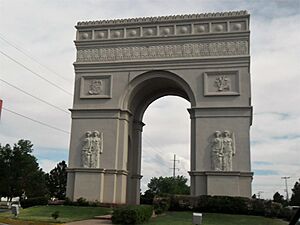
Ciudad Juárez has many different types of neighborhoods. Some are very wealthy, like Campestre and Campos Elíseos. Other areas are home to middle-class and working-class families. These include Infonavit and Las Misiones.
Population and People
| Historical population | ||
|---|---|---|
| Year | Pop. | ±% |
| 1990 | 789,522 | — |
| 2000 | 1,187,275 | +50.4% |
| 2010 | 1,321,004 | +11.3% |
| 2020 | 1,501,551 | +13.7% |
Between the 1960s and 1990s, Juárez's population grew a lot. This was partly because of the new maquiladora factories. Also, a program called the Bracero Program ended. This brought many workers back to border cities like Ciudad Juárez.
The city's population grew by about 5.3% each year between 1990 and 2000. In 2010, the city had over 1.3 million people. Many people have moved to Juárez from other parts of Mexico. About 32% of the city's residents come from outside the state of Chihuahua.
Culture
Famous People from Juárez
- Juan Acevedo, a professional baseball player.
- Miguel Aceves Mejía, a singer and actor.
- Elizabeth Álvarez, an actress.
- Joaquín Cosío, an actor and director.
- Juan Gabriel, a famous singer.
- Eddie Guerrero, a WWE wrestler.
- Vanessa Guzmán, a beauty queen and actress.
- Johnny "J", a rapper and music producer.
- Karla Martínez, a TV show co-host.
- Luis Montes, a football player.
- Zudikey Rodriguez, a sprinter.
- Germán "Tin-Tán" Valdés, a famous actor.
- Ramón Valdez "Don Ramón", an actor.
Economy
Ciudad Juárez is a major manufacturing hub. It is known for attracting many new factories. fDi Magazine called it a "City of the Future" for its growth. The El Paso–Juárez area is a big center for making goods.
Many international companies have factories here. These include CommScope, Electrolux, and Foxconn. Other big names are Lexmark, Delphi, and Boeing. These companies have chosen Ciudad Juárez for their business.
The state of Chihuahua, where Juárez is located, often gets a lot of foreign investment. Many international shops, banks, and fast-food places are also in Juárez. Local business leaders are working to improve skills and technology in the city. For example, Technology Hub helps companies with new skills and automation. It also has Fab Lab Juarez, which teaches people about 3D printing and other modern tools.
Media
Newspapers
Juárez has several local newspapers. These include El Diario, El Mexicano, and El PM. El Diario de Juárez also started El Diario de El Paso in the U.S.
Online News
- Jrznoticias
- El Diario de Juárez (online version)
Transportation
Public Buses
The main way to get around the city is by public bus. Buses run on the main streets all day. A ride costs about eight pesos. The city government is working to replace older buses with new ones. They are also improving bus stops with shade.
A new bus system called ViveBus started in 2013. It is a bus rapid transit (BRT) system. This system is much faster than the old buses. The first route has 34 stations. It goes from north to south in the city.
Airport
The city has its own airport, Abraham González International Airport. It has flights to many Mexican cities. For flights to the United States, people use El Paso International Airport nearby.
Border Crossings
The first bridge across the Rio Grande was built over 250 years ago. Today, several bridges connect El Paso and Ciudad Juárez. These include the Santa Fe Street Bridge and the Bridge of the Americas. There are also other crossings nearby, like in Santa Teresa, New Mexico.
Rail Travel
In the past, there was a streetcar system in Juárez from 1881 to 1974. There was also a heavy rail line that went into El Paso, Texas. However, it no longer carries passengers.
Education
Most people in Ciudad Juárez can read and write. About 97.3% of people over 15 years old are literate. This is similar to the national average in Mexico.
Juárez has about 20 colleges and universities. Here are some of the largest:
- The Instituto Tecnológico de Ciudad Juárez (ITCJ) was founded in 1964. It was the first public college in the city.
- The Autonomous University of Ciudad Juárez (UACJ) started in 1968. It is the largest university in the city. It has several campuses for different subjects. These include biomedical sciences, social sciences, and engineering. The UACJ also has great programs for arts and sports.
- The Faculty of Political and Social Sciences of the Autonomous University of Chihuahua (UACH) is also in the city. Many people who work in media and news in Juárez studied here.
- The Monterrey Institute of Technology and Higher Education (ITESM) opened its campus in 1983. It is considered one of the best campuses of this institution.
- Other universities include the Autonomous University of Durango (UAD) and Universidad Tecnológica del Paso del Norte.
Technology Hub Juarez also offers programs for kids. Kids 2 Code teaches coding after school. Fab Lab Juarez helps people learn to use 3D printers and other modern tools.
See also
 In Spanish: Ciudad Juárez para niños
In Spanish: Ciudad Juárez para niños


